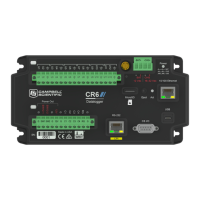example, the Network ID in all devices could be set to 1726, and the RF Hop Sequence in all
devices could be set to 1. The Network ID can be any number between 0 and 32767. The RF Hop
Sequence can be any number between 0 and 7 in an RF407 or RF412 network; it can be any
number between 0 and 9 in an RF422 network.
See also Radio communications option (p. 28). For specifications information, see RF radio
option specifications (p. 226).
9.6 Resetting the data logger
A data logger reset is sometimes referred to as a "memory reset." Backing up the current data
logger configuration before a reset makes it easy to revert to the old settings. To back up the
data logger configuration, connect to the data logger using Device ConfigurationUtility, and
click Backup > Back Up Datalogger. To restore a configuration after the data logger has been
reset, connect and click Backup > Restore Datalogger.
The following features are available for complete or selective reset of data logger memory:
l Processor reset
l Program send reset
l Manual data table reset
l Formatting memory drives
l Full memory reset
9.6.1 Processor reset
To reset the processor, simply power cycle the data logger. This resets its short-term memory,
restarts the current program, sets variables to their starting values, and clears communications
buffers. This does not clear data tables but may result in a skipped record. If the data logger is
remote, a power cycle can be mimicked in a Terminal Emulator program (type REBOOT <Enter>).
9.6.2 Program send reset
Final-data memory is erased when user programs are uploaded, unless preserve / erase data
options are used and the program was not altered. Preserve / erase data options are presented
when sending programs using File Control Send command and CRBasic Editor Compile, Save
and Send.
TIP:
It is good practice is to always retrieve data from the data logger before sending a program;
otherwise, data may be lost. See Collecting data (p. 49) for detailed instruction.
9. Tips and troubleshooting 135

